What are tire lug nuts?
While there are many different types of accessories for your vehicle out there, few perform as important a role as lug nuts. So, what are lug nuts, or lug bolts?
In short, lug nuts are the hardware used to secure your wheel and tire assembly to your vehicle. Having the correct lug nut ensures that your wheel is safely and securely installed. They may be small, but they perform a massive job.
While lug nuts vary in size and thread pitch, one of the most important differences in lug nut type is in the contact point where the lug nut meets the wheel, AKA the lug nut seat.
It's crucial that the lug nut seat and the wheel lug seat match. If they don't, the lug nuts/lug bolts may not safely secure your tire and wheel assembly to your vehicle.
So, let's break down the different types of lug nuts!
Lug Nut Types
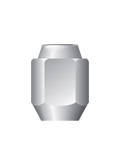
Conical or tapered seat lugs feature a cone-shaped lug seat.
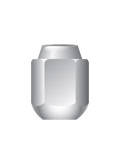
Spherical or ball seat lugs have a rounded lug seat.
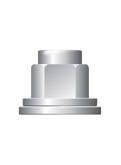
Flat Seat lugs have a flat, washer-like seat
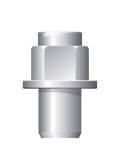
Mag Seat lugs also feature a flat washer seat but include a longer thread area.
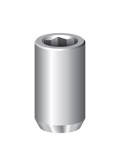
Tuner-style lugs have a conical seat, are typically very small in diameter, and are removed by using a special key that's inserted into the face of the lug nut.
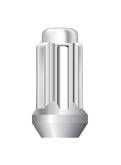
Small Diameter Spline Drive lugs have a small diameter and use a special key on the spline grooves with a conical seat
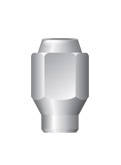
Extended Thread (ET) lugs also require a special key for the spline grooves and have a conical seat.
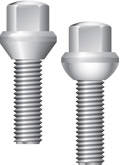
Lug Bolts are lug nuts that have the stud attached. They bolt into the rotor, rather than onto a stud. They're typically seen on European vehicles like Audi, BMW, Mercedes and Volkswagen.
When installing lug bolts, they must be the correct length for your vehicle. If they're too long, lug bolts can cause movement issues. After installing your lug bolts, spin the wheel while it's off the ground, making sure it has 360 degrees of motion.
Lug Nut Sizes
To safely install your wheels, the lug nut size must match your vehicle's requirements. If your lug nuts or lug bolts don't match your vehicle's thread pitch, they won't work on your ride.
Lug nut sizes are given in two numbers. The first number is the diameter of the stud. The second number is the thread pitch. On metric studs, the thread pitch is the distance in millimeters between each thread. On standard lug nuts, the thread pitch is the number of threads per inch.
For example, a 12mmx1.25 lug nut has a 12mm diameter and a thread pitch of 1.25mm.
Here are the most common lug nut sizes:
-
10mm X 1.25
-
12mm X 1.25
-
12mm X 1.50
-
12mm X 1.75
-
14mm X 1.25
-
14mm X 1.5
-
14mm X 2.0
-
7/16" X 20
-
1/2" X 20
-
9/16" X 18
Note: Most lug nuts are right-hand threaded, meaning they follow the "righty-tighty, lefty-loosey" rule. Left-hand threaded lug nuts, or lug nuts that tighten by rotating to the left, are not very common. They're typically marked with an "L" or "LHT" on the side of the lug nut.
What lug nuts do I need for aftermarket wheels?
If you want to give your ride a style upgrade that also packs a performance punch, there's nothing better than a new set of aftermarket wheels.
But when replacing your original equipment (OE) wheels, it's important to make sure you have lug nuts that fit properly. Most OE lug nuts are not designed to fit aftermarket wheels. That's why we recommend purchasing a wheel installation kit to ensure your new wheels come with lug nuts that fit!
Having trouble deciding on which aftermarket wheels are the best pick for you? Check out our wheel visualizer to see how your favorite rims look on your ride! And if it's time for new rubber, just let Treadwell guide you to the right set of tires for your driving needs. After all, a custom tire and wheel package is the best way to ensure a seamless upgrade to your ride!
Plus, we have the lowest prices on our massive inventory of wheels and tires, so you can upgrade and save at the same time!
What is lug nut thread engagement?
Another important consideration when replacing or installing lug nuts? Lug nut thread engagement.
Thread engagement refers to how much contact your lug nut has with the stud, or how many complete turns before it's tight. For your safety, proper thread engagement must be met.
If regular lug nuts can't make proper thread engagement, you might need extended thread (ET) lug nuts. When installing ET lug nuts, make sure the lug holes in the wheel are wide enough to accommodate the extended thread area.
For your wheels to be secured properly, they must meet the proper thread engagement. Feel free to bring your wheels and lug nuts to us. We'll make sure they have the proper thread engagement, and we can even install them for you!
What is lug nut torque?
Lug nut torque is the amount of force used to tighten your lug nuts. Every vehicle comes with its specific torque requirements. Measured in foot-pounds (ft-lbs), lug nut torque is critical when installing your lug nuts because it ensures a safe, secure fit.
If overtightened, both the lug nut and the stud can be fatigued, possibly leading to failure. If under-torqued, the lug nuts may not be securely installed.
Want to learn more about the proper lug nut torque settings for your vehicle? Check out our wheel torque chart!
Why is the outside diameter of lug nuts important?
When it comes to installing or replacing your lug nuts, you might find yourself wondering: why is the outside diameter of a lug nut important? It's important because the shape and size of the lug head determines which tool you need to successfully install your lug nuts!
Most lug nuts have a hex nut shape that will fit regular sockets you can find in most toolsets. Others have a spline-like shape that requires a special key. Many, including OE and aftermarket lug nuts, use a locking lug, which requires a serial-numbered lug key for installation or removal.
Additionally, some aftermarket wheels use a very small diameter lug nut that may require an adapter. This adapter might not be the same size as the OE lug head diameter.
Whatever lug nuts you have on your vehicle, make sure you've got the hardware you need to successfully install or remove your lug nuts.
Replacing Lug Nuts
One question we encounter often is, "When do I need to replace my OE lug nuts?" The truth is, it can vary quite a bit. Many OE lug nuts will last many years without ever needing to be replaced. Others may not be so reliable.
Some OE lug nuts have a tin cap. This cap may look nice, but it can come loose or begin to swell and warp over time. While these issues might not cause your lug nuts to detach, they can become a problem when you need to remove your wheels.
If the cap swells, it can get too big for your lug wrench to fit over it. If the cap falls off completely, the lug nut will be slightly smaller than the lug wrench, causing the lug wrench to slip and strip out the lug nut. In either case, it can be difficult, if not impossible, to remove your lug nuts without special tools.
Here are some visuals to help illustrate these issues:
Swollen Cap:
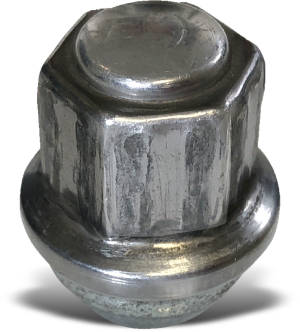
Cap Missing:
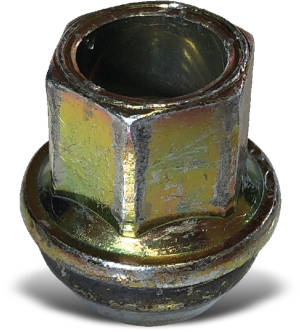
If your lug nuts have either of these issues, we recommend replacing them with aftermarket lug nuts as soon as possible.
Our aftermarket lug nuts are built with a solid, one-piece construction. They don't have caps and are made of the strongest grade materials, so you can count on them to keep their shape and keep your wheels securely in place.
Aftermarket Lug Nut:
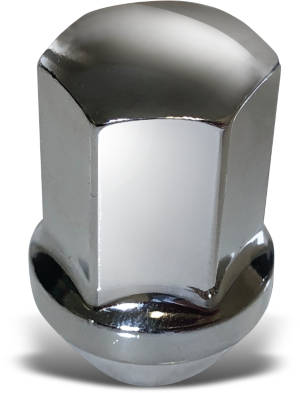
Have any more questions about lug nuts, wheel torque, aftermarket wheels or anything else? Stop by any of our America's Tire locations and we'll get you taken care of! Customers who buy and book online save time in-store!
